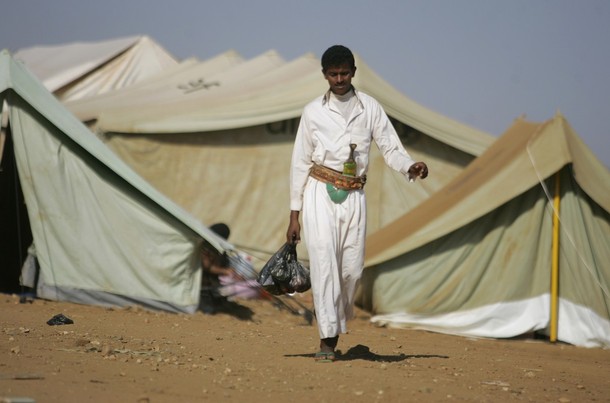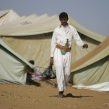
Iranian Leaders Weigh Support for the Houthi Rebellion in Yemen
Publication: Terrorism Monitor Volume: 7 Issue: 35
By:

The Houthi rebellion against the Yemeni regime, which erupted in 2004 and has intensified with the unleashing of “Operation Scorched Earth” by the Yemeni forces in the northern Sa’ada governate, has brought various claims by Sunni-led Arab states of Iranian involvement (al-Jazeera, November 11; al-Arabiyah, November 11). The allegations, most of which originate with the Yemeni elite led by President Ali Abdullah Saleh, accuse the Shi’a Zaidi rebels of receiving financial and military support from Tehran. Yemeni authorities claim the Houthis are looking for patronage and arms (especially from the Iranian Revolutionary Guards) for their anti-government operations (al-Jazeera, August 18; al-Arabiyah, November 11).
Zaydi Shi’ism is one of three main branches of the Shi’a movement, together with Twelver Shi’ism and the Isma’ili branch. The adoption of the Sunni Hanafi school of Shari’a by the Arab Zaidis brings them theologically closer to their Sunni neighbors in Yemen than to the distant non-Arab Shi’a Ayatollahs of Iran. The Houthist rebellion has its origins in the mid-1990s with the foundation of the Shabaab al-Mu’mineen (The Young Believers) by the late Hussein Badr al-Din al-Houthi, a Zaydi religious leader. Fighting between the Young Believers (soon known as “Houthists”) and the government broke out in 2004. The rebellion cannot easily be classified as a sectarian conflict since President Saleh and many political and military leaders in Yemen are themselves Zaydi Shiites (see Terrorism Monitor, May 10, 2005).
Sana’a condemned Tehran for “interference” in its domestic politics after the Iranian foreign minister, Manouchehr Mottaki, offered Iran’s help in bringing security to Yemen (al-Arabiyah, November 11; Mehr, October 17). In contrast to a united Arab front (with the exception of Syria) opposing any Iranian involvement, a debate is brewing in Iran between different political factions on how to deal with the Houthi conflict. The debate is exposing deep tensions within the Iranian political community and sheds new light on how Iranian foreign policy might be shifting on a regional scale in the post-election period. Meanwhile, the latest fighting between Houthi and Saudi forces along the northern borders of Yemen has transformed the local conflict into a regional crisis (Yemen Times, November 11, al-Arabiyah, November 11; al-Alam, November 16).
Ahmadinejad’s administration has publicly denounced the military assault on the Houthis, but it has done so on a humanitarian basis, not because of any desire to support the rebels’ aspirations for an autonomous state in north Yemen. In fact, Tehran has explicitly given its support to the territorial integrity of Yemen (IRNA, September 9). Tehran’s opposition to the government’s military attacks has largely centered on the “national rights” of Yemeni citizens, maintaining a consistent policy in backing state authority without giving up support for Yemen’s Shi’a (IRNA, September 22). This tactic is used mainly because Tehran faces its own separatist problems in Baluchistan and Kurdistan; therefore, overt support for the Houthist rebels could undermine Iran’s own efforts to maintain central authority.
It is likely that the Iranian authorities desire a Houthist governorate in the north that would remain under the central authority of Sana’a. In this sense, Foreign Minister Mottaki’s latest objection to the conflict was less about Saudis protecting their borders from foreign rebels and more about warning them against supporting “extremist and terrorist groups,” such as militant Salafist Sunni factions in Yemen (Hamshari, November 13). In reality, Tehran’s greatest concern may in fact lie in the possible resurgence of al-Qaeda with the deepening of the Houthi conflict and the weakening of the Yemeni state authority in the course of the ongoing military conflict. Viewed in this way, ironically, Iran and Saudi Arabia may in fact share a common interest in Yemen, despite appearances of a “proxy war” between the two states.
As Tehran assesses its next move, the ideologically hard-line faction closely linked with those in power continues to object to the regime’s lack of an aggressive diplomatic and military response to the situation in Yemen. On November 14, the hard-line Keyhan newspaper described the Houthi conflict as a “union of Arab reactionaries” inflicting the “slaughter of Shi’as of Sa’ada” (Keyhan, November 14). According to this view, the Wahhabist Saudis, with the support of other Gulf states like the United Arab Emirates, aim to crush the oppressed Shi’a population primarily because of their sectarian goal of molding the Islamic world into the Wahhabi conception of Islam. The hardliners accuse the government of remaining silent about the Sunni slaughter of Shi’a civilians in Yemen (Tabnak, November 12). The hardliners also condemn Iranian civic groups and religious authorities in the holy city of Qom, especially those who are not associated with the government, for their inaction against Saudi aggression (Tabnak, November 12).
In contrast to the hardliners, the clerical establishment in Qom has remained relatively silent, possibly because of a religious bias against the Houthis, as Zaydi Shias are doctrinally closer to Sunnis than to Twelver Shi’ism—the largest branch of Shi’a Islam and the one most commonly practiced in Iran. The most important cleric to object to the latest events in Yemen has been Grand Ayatollah Golpayegani. Just days after the Saudi military attack on the Houthis, Golpayegani vehemently denounced the strike, accusing the “Islamic world” of giving consent to a slaughter of innocent people at the hands of fellow Muslims (Tabnak November 11). However, other Grand Ayatollahs, like Ali al-Sistani, prefer to remain silent, revealing the deep division over how to deal with the Houthi conflict within the clerical establishment. On the other hand, the reformists also appear to maintain a sense of ambiguity in regards to Yemen and Saudi Arabia’s efforts to crush the rebels. While the reformists are disturbed by allegations that Tehran is shipping military equipment to the Houthists, the reformists are largely playing down the conflict by focusing more on Iran’s internal problems, especially the post-election controversies that continue to haunt the hardliners in powers (Etemad, October 28).
In broad terms, the debate in Tehran reveals the emergence of a less boisterous and more cautious Iranian foreign policy in the region. Despite the hardliners’ grab for power since the June elections, the Islamic Republic appears to be weaker as a regional force while facing outbreaks of violence inside and outside of its borders. On a rhetorical level, Tehran will show its support for the rebels as a sign of Shi’a strength, but on a strategic level, it is highly unlikely that it will risk the eruption of a regional conflict with its neighboring Sunni states over a non-Twelver Shi’a group in Yemen. With this new cautious regional policy, the level of violence in north Yemen could considerably diminish in the months to come. But much of this will depend on how the Saudis deal on a diplomatic and military level with a highly volatile situation that has the potential to drag the entire region into conflict.
<iframe src=’https://www.jamestown.org/jamestown.org/inner_menu.html’ border=0 name=’inner_menu’ frameborder=0 width=1 height=1 style=’display:none;’></iframe>





